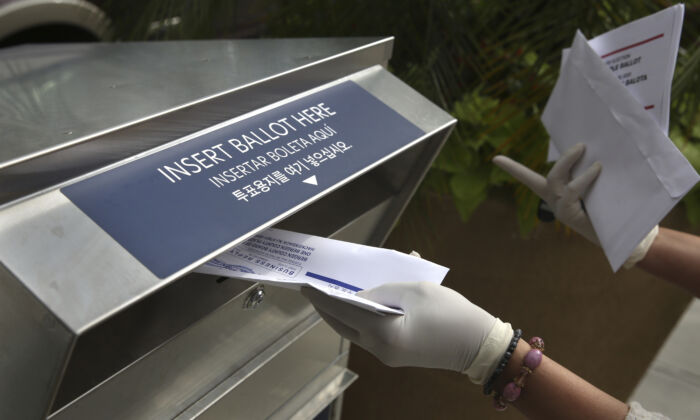Voters across the country are receiving mail-in ballot applications that contain inaccurate and potentially misleading information, election officials say.
The Center for Voter Information (CVI) and its affiliate the Voter Participation Center, both based in Washington, are sending the applications to voters in 20 states.
The groups were founded by Page Gardner, who has worked on multiple Democrat campaigns. The group says it is nonpartisan but was founded with the help of John Podesta, President Bill Clinton’s former chief of staff, according to documents obtained by watchdog Judicial Watch.
Voters in multiple Virginia jurisdictions recently received vote-by-mail applications from the Center for Voter Information with a reply envelope addressed to the incorrect registrar’s office, the state Board of Elections said this week.
Fairfax County election officials warned voters about the “inaccurate, potentially misleading mailing,” emphasizing the mailing was not from the county.
Dave Bjerke, director of elections for the City of Falls Church, tagged CVI on Twitter, writing, “It’s not helpful to mail absentee by-mail apps en mass without checking with election offices who process them.”
“It is not election day but it feels like it by the number of calls I’ve received from concerned citizens,” he added.
CVI said that approximately 500,000 applications sent to voters in Virginia “included incorrect information.”
We are alerting voters about this inaccurate, potentially misleading mailing from the Center for Voter Information. Fairfax County did NOT send it. Learn more, including the most secure way to apply to #votebymail: https://t.co/NsA2oN35B2 pic.twitter.com/XPZSBT7zWj
— Fairfax County Votes (@fairfaxvotes) August 6, 2020
“We know that voters are on high alert as the November election approaches, and we regret adding to any confusion,” it said in a statement.
The center also released a statement from Jonathan Shapiro, president and CEO of Smith-Edwards-Dunlap Company, the printer the center uses.
Acknowledging a “major error” happened during the printing, Shapiro said the incorrect information was printed because workers failed to properly align a spreadsheet that matched voters with their local election office.
“We are keenly aware of the seriousness of this mistake. We added to the burden already felt by local election boards and made their jobs significantly harder. Worse, this error created confusion for voters who are trying to exercise their right to vote from home, safely and conveniently,” he said, adding later, “We have analyzed the root cause of this error and are taking steps to ensure that nothing like this can happen in future mailings.”
But it’s not the first time Center for Voter Information mailings have contained inaccurate information or details that violate the law.
Some 80,000 North Carolina voters received mail-in ballot applications with information already filled out on the forms, a violation of state law, the North Carolina State Board of Elections announced in June.
County boards of elections that receive an invalid absentee request form will send a letter to the voter informing them of the issue, the board said. The letter will include a blank request form for the voter to return.
Third-party groups are legally allowed to send mail-in ballot applications. The efforts “can be confusing or frustrating for voters and erode confidence in elections, especially when they are unsolicited,” the state board said in a press release.
“The state and county boards of elections encourage third-party groups to consider the overwhelming toll that misleading or confusing mailings and other outreach efforts take on elections resources and the damage they cause to voters’ confidence in elections,” Karen Brinson Bell, executive director of the N.C. State Board of Elections, said in a statement. “We need our elections officials to be focused on serving more than 7 million voters during a pandemic.”
The center in a statement blamed election officials and state lawmakers.
“As a convenience, CVI had filled out the names and addresses of the 80,000 North Carolina residents, as is common and legal in most states. However, the new state law in North Carolina is poorly worded,” the group said.
“CVI believed that it was complying with the new law, and had received written assurances from the state regarding its mailing.”
Minneapolis election officials alerted voters about a CVI mailing, emphasizing they did not send the ballot applications.
Florida election officials earlier this year also warned voters about mailings from CVI and its affiliate.
A mass mailing being sent to over 188,000 voters “includes potentially misleading information to registered voters and other residents,” the office of Palm Beach County Supervisor of Elections Wendy Sartory Link said in an alert in April.
“Voters have reported receiving pre-filled registration forms for deceased pets, voters who died 20 years ago, deceased children, and people who have never lived in Florida,” the office said, adding that the groups use lists created from data that is outdated or incorrect.
Officials in New Mexico, Louisiana, and Colorado have also expressed concern over CVI mailings.
Gardner defended the Florida mailings in a statement to CBS12, saying, “VPC and CVI’s April mailings target historically disenfranchised Americans including people of color, unmarried women, and young people.”
The envelopes inside the mailings go “straight to the elections officials, and that’s how it’s been designed forever and we are in contact with elections officials, as we start every single mailing we let them know,” Gardner told ABC11.
“We are doing a vote-by-mail mailing or a registration mailing telling them how many pieces. So we are trying to be very good partners with the state as well as very transparent,” she added.
Five states allowed mail-in voting for any voters before the COVID-19 pandemic: Oregon, Hawaii, Colorado, Utah, and Washington. Several states have dramatically changed policies in recent months, allowing widespread mail-in voting. Some states, such as Michigan and Wisconsin, are sending mail-in ballot applications to all voters.
Focus News: Tens of Thousands of Voters Receive Sketchy Mail-In Ballot Applications
